The Radiation Detection Device Market is estimated to be valued at USD 2.1 billion in 2025 and is projected to reach USD 3.3 billion by 2035, registering a compound annual growth rate (CAGR) of 4.6% over the forecast period.
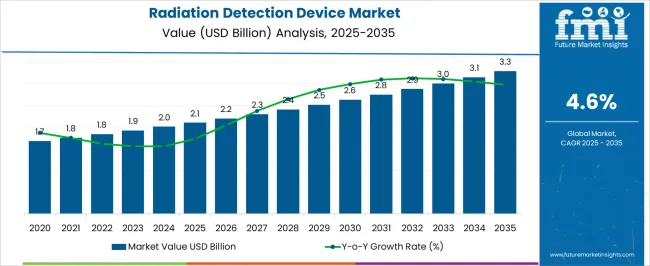
| Metric | Value |
|---|---|
| Radiation Detection Device Market Estimated Value in (2025 E) | USD 2.1 billion |
| Radiation Detection Device Market Forecast Value in (2035 F) | USD 3.3 billion |
| Forecast CAGR (2025 to 2035) | 4.6% |
The Radiation Detection Device market is experiencing steady expansion due to the increasing need for safety monitoring and hazard prevention across multiple industries, particularly in industrial, nuclear, and electronics applications. The market is being influenced by the growing deployment of detection systems for environmental monitoring, workplace safety, and compliance with stringent radiation regulations.
Advances in sensor technology and data processing have enabled devices to deliver faster, more accurate detection and reporting, which has increased adoption among both industrial and commercial end users. Investment in safety infrastructure and heightened awareness of radiation hazards are driving organizations to replace legacy systems with modern, software-enabled detection solutions.
The market’s future trajectory is expected to be shaped by the integration of advanced analytics, real-time reporting, and IoT connectivity, allowing devices to provide actionable insights remotely Increasing global focus on occupational safety and regulatory compliance is reinforcing demand, positioning radiation detection devices as essential tools for maintaining operational safety while minimizing risks across various sectors.
The radiation detection device market is segmented by type, end user, component, distribution channel, and geographic regions. By type, radiation detection device market is divided into LAN Tester, MAN Tester, and WAN Tester. In terms of end user, radiation detection device market is classified into Computer And Electronics Industry, Educational Institutes, Research Laboratories, Large Enterprises, Government Agencies, and Other Business Segments. Based on component, radiation detection device market is segmented into Hardware and Software. By distribution channel, radiation detection device market is segmented into OEMs, Distributors, and E-Commerce Portals. Regionally, the radiation detection device industry is classified into North America, Latin America, Western Europe, Eastern Europe, Balkan & Baltic Countries, Russia & Belarus, Central Asia, East Asia, South Asia & Pacific, and the Middle East & Africa.
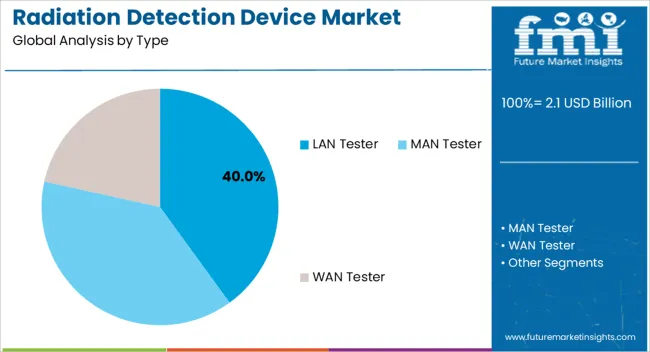
The LAN Tester type is projected to hold 40.0% of the Radiation Detection Device market revenue share in 2025, making it the leading device type. This dominance is being attributed to the requirement for accurate detection in complex networking environments and laboratory testing facilities where LAN-based systems are widely used.
Adoption has been facilitated by the devices’ capability to integrate with digital monitoring systems, allowing automated testing and real-time diagnostics. The growth of this segment has been driven by the increasing deployment of radiation-sensitive components in electronics and industrial equipment, which necessitate frequent monitoring for performance and safety compliance.
As workplaces continue to prioritize safety protocols and operational efficiency, LAN Tester devices provide cost-effective, reliable, and scalable solutions for radiation detection Furthermore, the segment has benefited from advances in sensor precision, firmware upgradeability, and interoperability with other monitoring systems, which have collectively reinforced its position as the most preferred type in the market.
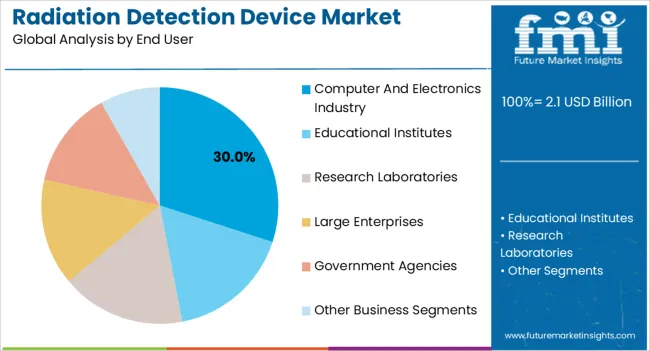
The Computer and Electronics Industry is anticipated to account for 30.0% of the Radiation Detection Device market revenue in 2025, emerging as the largest end-use industry. This growth is being driven by the increasing incorporation of radiation-sensitive materials and semiconductors in electronics manufacturing, which requires continuous monitoring to ensure quality, safety, and compliance with industry standards.
Organizations are increasingly deploying detection devices to safeguard personnel and equipment from hazardous exposure, as well as to maintain the integrity of sensitive electronic components. The segment’s growth has been supported by rising investments in research and development, stricter safety regulations, and the expansion of electronics production facilities in emerging markets.
Automation and integration of software-controlled radiation detection systems have further facilitated operational efficiency while minimizing risk As digital devices continue to proliferate and industries adopt more sophisticated electronics, the Computer and Electronics Industry segment is expected to maintain its leadership due to its high demand for accurate, reliable, and scalable radiation monitoring solutions.
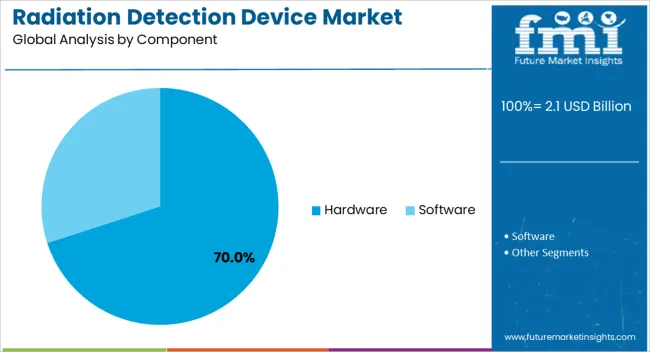
The Hardware component is projected to represent 70.0% of the Radiation Detection Device market revenue share in 2025, making it the dominant component segment. This leadership is being attributed to the critical role of sensors, detection units, and circuitry in ensuring accurate radiation measurement and real-time alerting. Hardware reliability and precision are essential for applications in industrial, commercial, and laboratory settings, where performance failures can have severe consequences.
The growth of this segment has been reinforced by advancements in sensor technology, miniaturization, and integration with software for analytics and monitoring. Organizations prefer hardware-focused devices for their robustness, long operational life, and ease of deployment in demanding environments.
Additionally, modular hardware designs allow for easy upgrades and maintenance without requiring full system replacement, which further supports adoption As demand for high-accuracy detection continues to rise across multiple end-use industries, the Hardware component segment is expected to sustain its leading position in the market, providing the foundational capability for reliable radiation monitoring and safety assurance.
The network is the communication between two or more computer systems. In practice, a network is comprised of a number of different computer systems connected by physical and/or wireless connections. Digital transformation has led to exponential growth of IP-connected devices, including wireless access points, digital lighting, and access control devices, etc.
As more organizations embrace mobile computing and consumers increasingly rely on mobile devices to manage their always-on, hyper-connected world, Wi-Fi networks are quickly becoming the backbone for delivering optimal user experience. The immense use and dependency on the network, put some pressure on the entire network infrastructure, requiring major updates including new, high-powered power over Ethernet across the industry segments.
The fast and seamless network becomes critical when most of the government and business operative depend on it. For organizations challenged by the rapid growth of network-connected devices, network connectivity testers, enables installers and IT professional to accelerate deployments and identify the uneven speed problem as well as improve the efficiency and effectiveness of the work.
Network connectivity testers thus become a necessity of every network system across the globe.
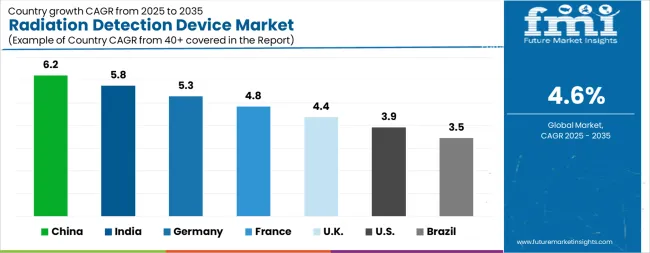
| Country | CAGR |
|---|---|
| China | 6.2% |
| India | 5.8% |
| Germany | 5.3% |
| France | 4.8% |
| U.K. | 4.4% |
| U.S. | 3.9% |
| Brazil | 3.5% |
The Radiation Detection Device Market is expected to register a CAGR of 4.6% during the forecast period, exhibiting varied country level momentum. China leads with the highest CAGR of 6.2%, followed by India at 5.8%. Developed markets such as Germany, France, and the U.K. continue to expand steadily, while the U.S. is likely to grow at consistent rates. Brazil posts the lowest CAGR at 3.5%, yet still underscores a broadly positive trajectory for the global Radiation Detection Device Market. In 2024, Germany held a dominant revenue in the Western Europe market and is expected to grow with a CAGR of 5.3%. The U.S. Radiation Detection Device Market is estimated to be valued at USD 793.6 million in 2025 and is anticipated to reach a valuation of USD 1.2 billion by 2035. Sales are projected to rise at a CAGR of 3.9% over the forecast period between 2025 and 2035. While Japan and South Korea markets are estimated to be valued at USD 112.8 million and USD 57.3 million respectively in 2025.
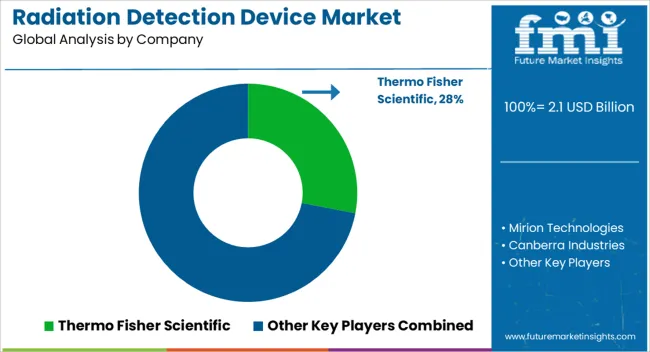
| Item | Value |
|---|---|
| Quantitative Units | USD 2.1 Billion |
| Type | LAN Tester, MAN Tester, and WAN Tester |
| End User | Computer And Electronics Industry, Educational Institutes, Research Laboratories, Large Enterprises, Government Agencies, and Other Business Segments |
| Component | Hardware and Software |
| Distribution Channel | OEMs, Distributors, and E-Commerce Portals |
| Regions Covered | North America, Europe, Asia-Pacific, Latin America, Middle East & Africa |
| Country Covered | United States, Canada, Germany, France, United Kingdom, China, Japan, India, Brazil, South Africa |
| Key Companies Profiled | Thermo Fisher Scientific, Mirion Technologies, Canberra Industries, Landauer Inc., Kromek Group, Fluke Biomedical, and Ludlum Measurements |
The global radiation detection device market is estimated to be valued at USD 2.1 billion in 2025.
The market size for the radiation detection device market is projected to reach USD 3.3 billion by 2035.
The radiation detection device market is expected to grow at a 4.6% CAGR between 2025 and 2035.
The key product types in radiation detection device market are lan tester, man tester and wan tester.
In terms of end user, computer and electronics industry segment to command 30.0% share in the radiation detection device market in 2025.






Our Research Products

The "Full Research Suite" delivers actionable market intel, deep dives on markets or technologies, so clients act faster, cut risk, and unlock growth.

The Leaderboard benchmarks and ranks top vendors, classifying them as Established Leaders, Leading Challengers, or Disruptors & Challengers.

Locates where complements amplify value and substitutes erode it, forecasting net impact by horizon

We deliver granular, decision-grade intel: market sizing, 5-year forecasts, pricing, adoption, usage, revenue, and operational KPIs—plus competitor tracking, regulation, and value chains—across 60 countries broadly.

Spot the shifts before they hit your P&L. We track inflection points, adoption curves, pricing moves, and ecosystem plays to show where demand is heading, why it is changing, and what to do next across high-growth markets and disruptive tech

Real-time reads of user behavior. We track shifting priorities, perceptions of today’s and next-gen services, and provider experience, then pace how fast tech moves from trial to adoption, blending buyer, consumer, and channel inputs with social signals (#WhySwitch, #UX).

Partner with our analyst team to build a custom report designed around your business priorities. From analysing market trends to assessing competitors or crafting bespoke datasets, we tailor insights to your needs.
Supplier Intelligence
Discovery & Profiling
Capacity & Footprint
Performance & Risk
Compliance & Governance
Commercial Readiness
Who Supplies Whom
Scorecards & Shortlists
Playbooks & Docs
Category Intelligence
Definition & Scope
Demand & Use Cases
Cost Drivers
Market Structure
Supply Chain Map
Trade & Policy
Operating Norms
Deliverables
Buyer Intelligence
Account Basics
Spend & Scope
Procurement Model
Vendor Requirements
Terms & Policies
Entry Strategy
Pain Points & Triggers
Outputs
Pricing Analysis
Benchmarks
Trends
Should-Cost
Indexation
Landed Cost
Commercial Terms
Deliverables
Brand Analysis
Positioning & Value Prop
Share & Presence
Customer Evidence
Go-to-Market
Digital & Reputation
Compliance & Trust
KPIs & Gaps
Outputs
Full Research Suite comprises of:
Market outlook & trends analysis
Interviews & case studies
Strategic recommendations
Vendor profiles & capabilities analysis
5-year forecasts
8 regions and 60+ country-level data splits
Market segment data splits
12 months of continuous data updates
DELIVERED AS:
PDF EXCEL ONLINE
Seizure Detection Devices Market
Arc Fault Detection Devices Market Size and Share Forecast Outlook 2025 to 2035
Skin Cancer Detection Devices Market Size and Share Forecast Outlook 2025 to 2035
Non-ionizing Radiation EMF Detection, Measurement, and Safety Market Size and Share Forecast Outlook 2025 to 2035
Pressure Ulcer Detection Devices Market Trends – Growth & Forecast 2025 to 2035
Endoscope Leak Detection Device Market
Counterfeit Drug Detection Device Market Size and Share Forecast Outlook 2025 to 2035
Heart Beat Irregularity Detection Device Market Trends - Growth & Forecast 2025 to 2035
Radiation Tolerant LED Light Market Size and Share Forecast Outlook 2025 to 2035
Radiation Hardened Electronics Market Size and Share Forecast Outlook 2025 to 2035
Radiation Protection Cabins Market Size and Share Forecast Outlook 2025 to 2035
Radiation-Free Fetal Heart Rate Monitor Market Size and Share Forecast Outlook 2025 to 2035
Radiation Hardened Microcontrollers Market Size and Share Forecast Outlook 2025 to 2035
Radiation Curable Coatings Market Size and Share Forecast Outlook 2025 to 2035
Radiation Toxicity Treatment Market Size and Share Forecast Outlook 2025 to 2035
Device-Embedded Biometric Authentication Market Size and Share Forecast Outlook 2025 to 2035
Radiation-Induced Myelosuppression Treatment Market Size and Share Forecast Outlook 2025 to 2035
Radiation Dose Optimisation Software Market Size and Share Forecast Outlook 2025 to 2035
Radiation Therapy Software Market Size and Share Forecast Outlook 2025 to 2035
Radiation Tester Market Growth – Trends & Forecast 2025 to 2035

Thank you!
You will receive an email from our Business Development Manager. Please be sure to check your SPAM/JUNK folder too.
Chat With
MaRIA